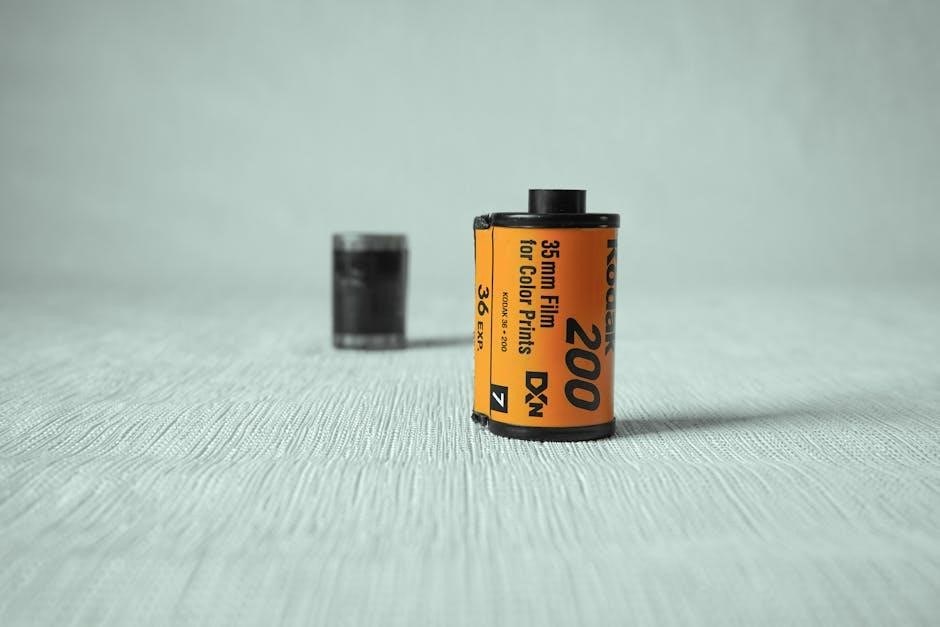Welcome to the AFP-200 Notifier Manual, your comprehensive guide to understanding and operating the AFP-200 intelligent fire alarm control panel. This manual provides essential information for installation, operation, and troubleshooting, ensuring optimal system performance and safety.
Overview of the AFP-200 Notifier System
The AFP-200 Notifier System is a state-of-the-art, intelligent fire alarm control panel designed for reliability and flexibility. It features a modular architecture, supporting up to 250 devices, including smoke detectors, heat detectors, and manual pull stations. The system operates on a rapid poll algorithm, ensuring swift responses to alarms and trouble conditions. With analog capabilities, it provides precise detection and advanced diagnostics. Compatible with a wide range of fire alarm devices, the AFP-200 is ideal for commercial and industrial applications. Its user-friendly interface and robust programming options make it a versatile solution for fire safety needs. The system is scalable, allowing for customization to suit various facility sizes and requirements. Manufactured by Honeywell, it is trusted for its performance and compliance with fire safety standards.
Importance of the Manual for System Operation
The AFP-200 Notifier Manual is crucial for proper system operation, providing detailed instructions for installation, programming, and troubleshooting. It ensures users understand safety protocols, configuration options, and maintenance routines. The manual acts as a reference guide, helping technicians and end-users optimize the system’s performance and address issues promptly. By following the manual, users can avoid errors, ensuring the system functions reliably and complies with safety standards. It serves as an essential tool for both initial setup and ongoing management of the AFP-200, making it indispensable for anyone involved in its operation and maintenance.

System Architecture and Components
The AFP-200 Notifier system features a modular design with key components like the control panel, detectors, and communication modules, ensuring scalable and reliable fire alarm monitoring.
Modular Design and Key Features
The AFP-200 Notifier is built with a modular design, allowing for flexible expansion and customization. Key features include a single loop intelligent fire alarm control, compatibility with a wide range of detectors, and advanced communication capabilities; The system supports up to 1,000 feet of unshielded wire, enabling efficient installation. Its rapid poll algorithm ensures quick response times, typically under 2 seconds, for manual stations. The panel also includes a lamp test feature for maintenance and troubleshooting. These features make the AFP-200 a robust and reliable solution for fire alarm systems, suitable for various applications and environments. The modular architecture ensures scalability, adapting to growing security needs.
Compatibility with Fire Alarm Detectors and Devices
The AFP-200 Notifier is compatible with a wide range of fire alarm detectors and devices, including smoke detectors, heat detectors, and manual pull stations. It also supports integration with audible warning devices, ensuring comprehensive fire safety coverage. The system works seamlessly with Fire-Lite devices, enhancing its versatility for various installations. Its compatibility extends to unshielded wires, allowing for efficient connections up to 1,000 feet. This broad compatibility ensures that the AFP-200 can be tailored to meet specific fire safety requirements, providing reliable performance across different environments. The system’s ability to integrate with multiple devices makes it a flexible solution for commercial and industrial fire alarm systems. This ensures enhanced safety and convenience for users.

Installation Guidelines
Follow the installation manual for step-by-step guidance on setting up the AFP-200 Notifier. Ensure proper wiring and device connections for optimal system performance and reliability.
Step-by-Step Installation Process
The installation of the AFP-200 Notifier system requires careful planning and adherence to the provided manual. Begin by mounting the control panel in a centralized location, ensuring accessibility for future maintenance. Next, connect the system’s wiring according to the wiring diagram, paying attention to proper connections for detectors, manual pull stations, and alarm devices. Power up the system and perform a self-test to verify functionality. Finally, configure the system settings as outlined in the manual, ensuring compliance with local fire safety regulations. Always refer to the installation manual for detailed instructions to avoid damage and ensure reliable operation.
Wiring Diagrams and Configurations
Wiring diagrams are essential for the proper installation and configuration of the AFP-200 Notifier system. These diagrams provide detailed layouts for connecting detectors, manual pull stations, and alarm devices. Ensure all zone wiring is correctly terminated to the control panel, following the recommended cable types and lengths. Use twisted and shielded cables for data communication to minimize interference. Power supply connections must be accurately wired to avoid damage to the system. Refer to the manual for specific wiring configurations, such as zone wiring, power connections, and communication links; Proper wiring ensures reliable performance, so always follow the manufacturer’s guidelines to prevent malfunctions. Incorrect wiring can lead to false alarms or system failure, emphasizing the importance of precise connections. Labeling wires during installation aids in future maintenance and troubleshooting.

Operation and Programming
The AFP-200 Notifier system offers intuitive operation through its keypad interface, enabling users to monitor zones, acknowledge alarms, and silence notifications. Programming allows customization of system settings, such as zone configurations, alarm levels, and response delays, ensuring tailored fire safety solutions for various applications. Advanced features include event logging and real-time status updates, providing comprehensive control and monitoring capabilities. Regular software updates enhance functionality, ensuring the system remains up-to-date with the latest safety standards and technological advancements.
Keypad Functions and Basic Operations
The AFP-200 Notifier system features an intuitive keypad interface designed for easy operation and monitoring. Users can access zone status, acknowledge alarms, and silence notifications directly from the keypad. The keypad also allows for basic system functions, such as performing a lamp test, resetting the system, and navigating through menu options. LED indicators provide visual feedback for system status, alarms, and faults, ensuring quick identification of issues. Basic operations include monitoring zones, reviewing event logs, and silencing audible alerts. The keypad is essential for day-to-day interaction with the system, enabling users to maintain control and ensure reliable fire safety monitoring. Regular use of these functions helps optimize system performance and response.
Programming the AFP-200 for Custom Settings
Programming the AFP-200 Notifier system allows for tailored configurations to meet specific fire safety requirements. Using the Notifier PK-1 software or terminal emulation tools, users can customize settings such as zone configurations, delay times, and sensitivity levels. The system supports advanced features like custom alarm responses and integration with other fire safety devices. Programming must be done carefully to avoid system malfunctions, as outlined in the manual. Key functions include setting up zone labels, enabling or disabling zones, and configuring alarm priorities. Users can also program custom messages and integrate with building management systems. Regular updates and backups are recommended to maintain system integrity. Always refer to the programming manual for detailed instructions and safety precautions. This ensures optimal performance and compliance with fire safety standards.

Maintenance and Troubleshooting
Regular maintenance ensures the AFP-200 operates reliably, while troubleshooting addresses common issues like false alarms or system errors, ensuring fire safety remains uncompromised always.
Routine Maintenance Checks
Performing regular maintenance on the AFP-200 is crucial for ensuring system reliability. Start by inspecting all connections and wiring for signs of wear or damage. Next, test the panel’s communication with all connected devices, such as smoke detectors and manual pull stations, to ensure they are functioning correctly. Check the system’s event log for any errors or alarms that may indicate issues. Additionally, clean the control panel and its components to prevent dust buildup, which can interfere with performance. Finally, verify that all software and firmware are up to date, as outdated versions may lead to compatibility problems. By following these routine checks, you can maintain the AFP-200’s optimal operation and ensure fire safety standards are met consistently.
Troubleshooting Common Issues
Troubleshooting the AFP-200 involves identifying and resolving common problems to ensure system functionality. Begin by checking error codes displayed on the keypad, which provide specific issue indicators. Loss of communication with detectors or devices often results from faulty wiring or incorrect connections, so inspect all cables and ensure they are securely attached. Additionally, verify that all devices are properly configured and compatible with the AFP-200. If the system fails to respond during testing, perform a system reset and conduct a lamp test to verify functionality. For persistent issues, consult the event log for detailed error history and refer to the manual for advanced diagnostic procedures. Regular maintenance and updates can prevent many common problems, ensuring reliable performance.
Additional Resources
Access PDF manuals, installation guides, and technical documents for the AFP-200 Notifier system. Visit the manufacturer’s website for support, updated software, and contact information for assistance.
PDF Manuals and Documentation
The AFP-200 Notifier system offers a range of downloadable PDF manuals and documentation to support installation, operation, and maintenance. These resources include the Installation Manual, Instruction Manual, and programming guides, providing detailed instructions for configuring the system. Additionally, supplementary documents like the AFP-200 Instruction Supplement are available for advanced features. These manuals are essential for understanding the system’s modular design, compatibility with fire alarm devices, and troubleshooting procedures. Ensure proper system operation by referring to these official guides. You can download these PDF files from the manufacturer’s website or authorized fire alarm resource platforms, guaranteeing access to accurate and up-to-date information.
Manufacturer Support and Contact Information
For any inquiries or assistance regarding the AFP-200 Notifier system, contact Notifier Inertia Pty Ltd at 7 Columbia Street. The manufacturer provides dedicated support for technical issues, ensuring proper installation and operation. Their team specializes in addressing questions about system configuration, troubleshooting, and compliance with fire safety standards. Visit their official website or call (203) for direct assistance. Access additional resources, including updated manuals and guides, on their platform. Ensure compliance and optimal performance by following their guidelines. Reach out to their support team for personalized help and reliable solutions. Their expertise guarantees seamless system functionality and adherence to safety protocols.
